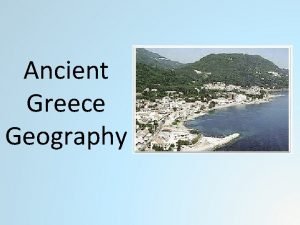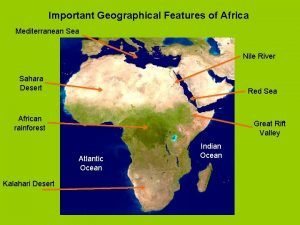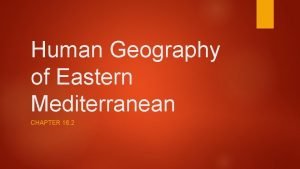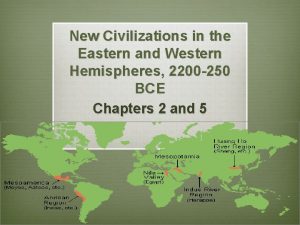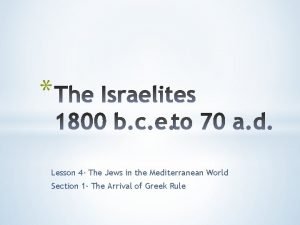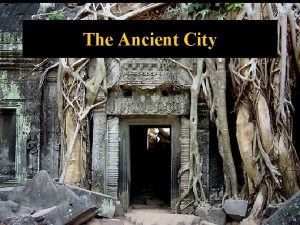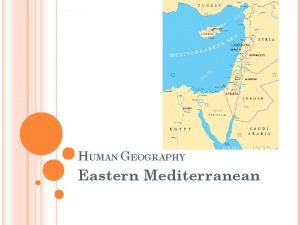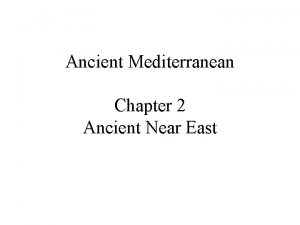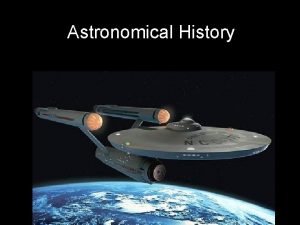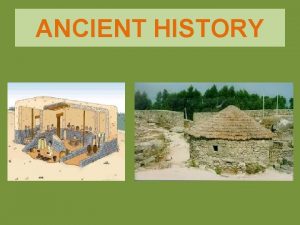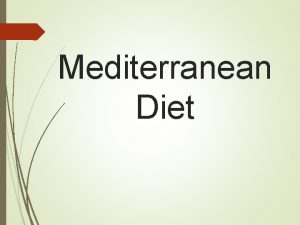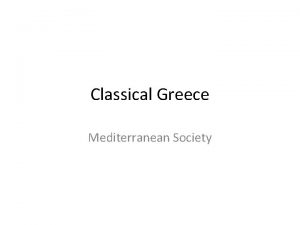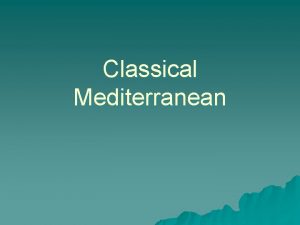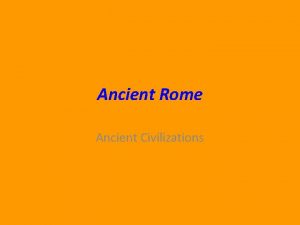History 2213 The Ancient Mediterranean City Lecture 10




























- Slides: 28

History 2213: The Ancient Mediterranean City Lecture 10: Athens and Sparta Kyle Tadlock

Announcements • Discussion for lectures 8 -10 due Weds. May 25

Athens and Sparta • Best known poleis • Many written sources • Also most atypical – Athens unusually large and wealthy – Sparta unusually large and militaristic – Most poleis fell between • Classical Age Greece (490 -323 BC)

Sparta • Peloponnese • Sparta – Unwalled urban center – Chora called Laconia • Laconia – Sparta never colonized – Took over Messina – Large and agriculturally rich

Early History of Sparta • City of King Menelaus in Trojan War • Resettled by Dorians in 10 th century BC • Sparta reemerges by c. 750 • Invade Messenia c. 700 – take over whole area – enslave natives and make helots • Rivalry with Argos

Spartan Society • Reformed by the Great Rhetra – Problems of helot revolt and war with Argos c. 670 -630 – Attributed to Lycurgus of Sparta • Remade society over time – Spartiates • ~8, 000 adult males dedicated to warfare • Held all political and military power – Perioikoi “The dwellers around” • Free citizens who were not Spartan • Non-Dorian population? – Helots • Owned by Spartan state • Assigned to a Spartiate with his kleros

Life in Sparta • Spartiates – Trained for war from age 7 – Entered into army at 20, retired at 60 – Became Spartiate at age 30 • Women – Freest in all Greece and ran kleros – Trained in athletics to have strong children – Taught Spartan ethos • Helots – Some protection and rights as state property – Could buy freedom and fight in wars – Kryptei and pruning

Spartan Government • Two elected kings from two families • Gerousia – 28 men + 2 kings – Elected for life from men 60 years and older – Executive council • Apella – General assembly – All Spartiates eligible • Ephors – 5 men elected yearly – Managed routine affairs and foreign policy – All-powerful and always accompanied kings

Spartan Foreign Policy • Only professional, nonmercenary Greek army • Rarely left home – Fear of helot revolt – Reputation important • Peloponnesian League – Most poleis of the Peloponnesus – Hegemonic – Had to contribute to any campaign

Athens and Attica • Attica – – – The chora of Athens 1, 000 square miles Scattered settlements Mountainous Olives, clay, stone, silver at Larium • Athens – Mycenaean fortress – Dark Age city on acropolis – Never colonized

Archaic History • Aristocrats in charge – Nine archons – Areopagus • • • Many peasants in debt or debt slavery C. 650, new class of merchants and hoplites Major problems and eventual stasis Cylon attempts tyranny in 632 Solon (638 -558) as nomothete in 594

Reforms of Solon • Debt slavery outlawed – Seisaktheia “Lifting of burdens” – Freed debt slaves at public expense • Encouraged trade and economic diversity – Subsistence farming to cash crops and pottery – Citizenship to foreigners with craft expertise • Written law code – Law available and applicable to all – Heliaia: court of appeals • Council of 400 • Set up a timocratic system

After Solon • Solon instituted reforms and then left for 10 years • Once again, stasis broke out between factions • Peisistratus (tyrant 546 -527) – Three attempts at tyranny, succeeded in 546 – “Good tyrant” – Redistributed land – Encouraged more economic diversity – Public works – Sons chased off with Spartan support in 510

Cleisthenes and Democracy • More stasis • Cleisthenes elected nomothetes in 508 • Wanted to prevent tyranny and factionalism – ~150 demes spread out geographically – 10 demes into trittyes – 1 trittyes from each region into a tribe – 10 new tribes (phyle) • Plan successful • Isonomia and demokratia

Reforms of Cleisthenes

Government of Athens I • Archons (9) – Religious, legal, and magisterial functions – Chosen by lot, no consecutive terms • Strategoi (Board of 10 Generals) – One from each tribe – Elected, could serve multiple terms • Boule (Council of 500) – – – 50 from each tribe Chosen annually by lot, only twice in a lifetime Male, over 30, member of first three property classes Executive council, chose legislation to be voted upon Represented Athens to outsiders

Government of Athens II • Ekklessia (General Assembly) – All males over 18, likely only 6, 000 at a time – Met on Pynx Hill – Voted on measures brought by boule • Dikasteria (Jury Pool) – 6, 000 judges chosen by lot – Open to all, many poor served because paid – Randomly selected for individual cases • Ostracism

The Others in Athens • Slaves – Common: 100 -150, 000? – Most zeugitai and above had at least one – No revolts, just ran away • Women – Role and treatment heavily debated – Oriental seclusion or queen bee? – Role in politics? – Dependent on class

Government in Pictures

Athenian Agora

Reconstruction

Democracy in Action kleroterion

Athenian Pottery

The Persian War/s • Punishment for Athens and Eretria participating in the Ionian Revolt • Land expedition of 492 fails • Sailing expedition launched in 490 – Sacks Eretria, sails toward Athens – Fleet lands at Marathon with Hippias where defeated • Sea/land expedition launched in 480 – – – At least 100, 000 men and 600 ships Hellenic League under Spartans and allies stand at Thermopylae Athens burned but people saved Persians defeated at Salamis (480), Platea, and Mycale (479)

An Overview

Defeat and Two Victories

The Aftermath • Athens leads Hellenic League after 477 • Forms the Delian League – – Mutual protection and drive Persians out of Aegean Liberated cities join and contributed ships or silver Headquartered on island of Delos 200 cities at end • Battle of Eurymedon in 469 • Delian League becomes an Athenian empire in 454 – – – Treasury moved to Athens Cleruchs as garrison Exclude trade rivals from controlled parts Impose democracy, commercial law, and coinage Cause stasis in subject cities

It’s a Big Delian
 Arbeidstidsavtale
Arbeidstidsavtale 01:640:244 lecture notes - lecture 15: plat, idah, farad
01:640:244 lecture notes - lecture 15: plat, idah, farad Ancient ways of communication
Ancient ways of communication Ancient india vs ancient china
Ancient india vs ancient china Ancient greece geography
Ancient greece geography Griffin ford model
Griffin ford model Cbd inner city outer city
Cbd inner city outer city Is mexico city a primate city
Is mexico city a primate city Unit 2 the united states and canada
Unit 2 the united states and canada Mediterranean diet bread
Mediterranean diet bread Make everyday mediterranean
Make everyday mediterranean Africa mediterranean
Africa mediterranean Chapter 16 eastern mediterranean answers
Chapter 16 eastern mediterranean answers Storms in the mediterranean sea
Storms in the mediterranean sea Dash vs mediterranean diet
Dash vs mediterranean diet Greek colonies in the mediterranean
Greek colonies in the mediterranean Ancel keys mediterranean diet
Ancel keys mediterranean diet Mediterranean civilizations location hemisphere
Mediterranean civilizations location hemisphere Mediterranean shipping cruises
Mediterranean shipping cruises Chapter 13 section 1 mediterranean europe
Chapter 13 section 1 mediterranean europe What was life like for the jews in greek-ruled lands?
What was life like for the jews in greek-ruled lands? Mediterranean forest
Mediterranean forest Mediterranean diet pesticides
Mediterranean diet pesticides Bioluminescence mediterranean sea
Bioluminescence mediterranean sea Mediterranean painters
Mediterranean painters Mediterranean sea map
Mediterranean sea map Danube mediterranean canal
Danube mediterranean canal General fisheries commission for the mediterranean
General fisheries commission for the mediterranean Mediterranean island nation
Mediterranean island nation




